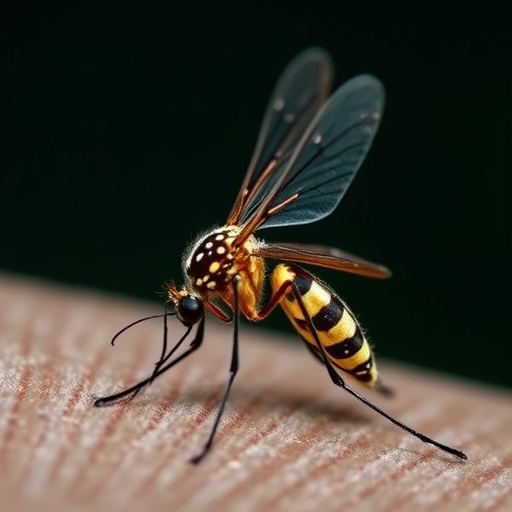In a groundbreaking advancement that melds cutting-edge artificial intelligence with the power of citizen science, researchers at the University of South Florida (USF) have potentially identified the first-ever specimen of the Anopheles stephensi mosquito in Madagascar. This discovery, documented in the peer-reviewed journal Insects and led by Dr. Ryan Carney and Dr. Sriram Chellappan, underscores a transformative approach to global disease surveillance, particularly for vector-borne illnesses that continue to threaten millions worldwide.
The invasive Anopheles stephensi species is of profound global health concern due to its efficient transmission of malaria, particularly in urbanized landscapes. Unlike native African Anopheles mosquitoes that predominantly breed in natural water bodies, An. stephensi thrives in artificial containers, such as discarded tires and buckets, creating unique challenges for disease containment. This adaptation has enabled the species to expand its reach across rapidly urbanizing regions, putting an additional estimated 126 million people in Africa at heightened risk of malaria infection.
The identification of this elusive vector in Madagascar was made possible by a single citizen-scientist-submitted image via NASA’s GLOBE Observer app, a platform empowering the public to contribute valuable scientific data through smartphone technology. The image—depicting a mosquito larva discovered in a tire—was subjected to AI-based image recognition algorithms, meticulously trained on thousands of authenticated mosquito images. Impressively, the algorithm classified the larva as Anopheles stephensi with an accuracy exceeding 99%, a testament to the maturation of machine learning in ecological and epidemiological applications.
This breakthrough detection signifies more than a singular discovery; it exemplifies a paradigm shift in public health surveillance. Traditional entomological monitoring methods often involve labor-intensive field collections and delayed laboratory analysis, leaving critical gaps where invasive species can establish and expand unnoticed. The integration of AI-driven diagnostics coupled with widespread public engagement through mobile applications dramatically accelerates detection timelines, enabling near-real-time monitoring of disease vectors on a scale previously unattainable.
Despite the inability to perform genetic confirmation—owing to the immediate destruction of the specimens post-collection—the consistency of findings, including observations of over 100 other Anopheles larvae in similar breeding sites on the same day, lends considerable weight to the identification. Notably, the same year as the discovery coincided with a precipitous doubling in malaria cases and fatalities in Madagascar, paralleling global concerns about the rapid spread of An. stephensi in new ecological niches.
This study is not solely about geographic discovery; it portends a looming public health crisis with direct implications beyond the African continent. In the United States, where malaria was long considered eradicated in local transmission contexts, 2023 witnessed localized outbreaks for the first time in over two decades. Florida emerged as a hotspot, reporting more cases than all other states combined, starkly highlighting the urgency of innovative surveillance tools.
Central to this initiative is the development of next-generation AI models that replicate the functionality of facial recognition technologies, but for mosquito larvae and adults. By harnessing extensive datasets of labeled mosquito imagery, these models not only distinguish between species with high precision but also facilitate scalable, cost-effective surveillance by non-experts. Such technological sophistication offers a complementary approach to genomic techniques and traditional surveillance, especially in resource-limited settings.
The multi-disciplinary collaboration at USF, spanning departments of Integrative Biology, Artificial Intelligence, Cybersecurity and Computing, and Public Health, reflects the complex intersection of ecology, technology, and health sciences necessary to confront mosquito-borne diseases. Supported by grants from the National Institutes of Health and National Science Foundation, this work builds upon prior award-winning research by the team and sets the stage for advanced hardware innovation, such as AI-enabled smart traps designed to automatically identify multiple mosquito species in situ.
The strategic vision articulated by the researchers envisions a future where smart traps equipped with embedded AI analyses serve as sentinel devices across urban and rural landscapes. These traps could autonomously transmit data on mosquito presence and species composition, thereby informing timely public health interventions, vector control strategies, and epidemiological modeling. This represents a proactive leap in disease control infrastructures, combining engineering and bioinformatics to outpace vector adaptation and spread.
Reflecting on the broader significance, Dr. Carney emphasized that although mosquitoes are commonly perceived as mere nuisances, a small fraction—approximately 3%—are vectors for human diseases. The deployment of citizen science applications paired with AI analytics empowers communities globally, enabling them to partake actively in identifying and mitigating threats posed by these disease vectors. This democratization of surveillance holds immense promise for enhancing public health resilience.
Dr. Chellappan added that the rising prominence of AI in public health domains cannot be overstated, particularly in mosquito surveillance where rapid identification and response are critical. The innovations spearheaded by the USF team are poised to transform epidemiological landscapes worldwide, fostering early-warning systems that can curb outbreaks before they proliferate extensively.
In sum, the USF-led initiative marks a seminal step in harnessing artificial intelligence and public participation to confront the complexities of invasive mosquito species and their attendant health risks. The convergence of AI, mobile technology, and community engagement charts a promising trajectory toward smarter, faster, and more inclusive global disease surveillance frameworks, offering hope in the ongoing battle against malaria and other mosquito-borne illnesses.
Subject of Research: Animals
Article Title: Artificial Intelligence and Citizen Science as a Tool for Global Mosquito Surveillance: Madagascar Case Study
News Publication Date: 28-Oct-2025
Web References:
- NASA’s GLOBE Observer app: https://observer.globe.gov/about/get-the-app
- Journal Insects: https://www.mdpi.com/journal/insects
- USF Faculty Ryan Carney: https://www.usf.edu/arts-sciences/departments/ib/people/faculty/ryan-carney.aspx
- USF Faculty Sriram Chellappan: https://www.usf.edu/ai-cybersecurity-computing/people/faculty/chellappan-sriram.aspx
References:
- Carney, R., Chellappan, S., et al. (2025). Artificial Intelligence and Citizen Science as a Tool for Global Mosquito Surveillance: Madagascar Case Study. Insects.
- Prior study: https://www.mdpi.com/2075-4450/13/8/675
Image Credits: Ryan Carney, University of South Florida (Credit: USF)
Keywords: Malaria, Parasitic diseases, Infectious diseases, Diseases and disorders, Public health




